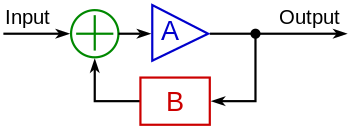Feedback
| Completion status: this resource is ~25% complete. |
Feedback is an important component of a variety of dynamic systems, including biological and organisation systems, as well as for learning and development.

"For any machine subject to a varied external environment to act effectively it is necessary that information concerning the results of its own action be furnished to it as part of the information on which it must continue to act. For example, if we are running an elevator, it is not enough to open the outside door because the orders we have given should make the elevator be at the door at the time we open it. It is important that the release for opening the door be dependant on the fact that the elevator is actually at the door; otherwise something might have detained it and the passenger might step into a empty shaft. This control of a machine on the basis of actual performance rather than its expected performance is known as feedback, and involves sensory members which are actuated by motor members and perform the function of tell-tales or monitors - that is, of elements which indicate a performance. It is the function of these mechanisms to control the mechanical tendency towards disorganization; in other words, to produce a temporary and local reversal of the normal direction of entropy." —Wiener, (1950)
Feedback is not just the formal response, but everything that a person or piece of equipment does in response to another's behaviour or performance.
Feedback for learning
editFeedback is critical to learning and development. For example, Hattie and Timperley (2011) identify feedback as the single most important variable in facilitating student outcomes.
[F]eedback is a method of controlling a system by reinserting into it the results of its past performance. If these results are merely used as numerical data for the criticism of the system and its regulation, we have the simple feedback of the control engineers. If, however, the information which proceeds backward from the performance is able to change the general method and pattern of performance, we have a process which may well be called learning.
In any process where learning is integrated with other activities, feedback is likely to play an important role.
Not all feedback is good, though, and Hattie and Timperley go on to identify the nature of effective feedback for fostering student development in educational settings.
Standard sequence
edit- Task: student is given task
- Performance:student does task
- Assessment: staff assesses student performance and gives feedback
- Re-iteration: student repeats tasks with improved performance.
- Evaluation: staff elicit feedback from student so that their performance at facilitating learning can itself be improved
Type of feedback
edit- Formative and summative (Scrivener) (USA)
- Assessment of and about learning (UK)
Feedback for communication
editIn human communication, feedback is undderstood to be important in developing effective relationships, including for managing conflict and improving cooperation and mutual understanding.
Feedback in design and project management
editFeedback can be integrated into the design process through use of Iterative and incremental development. This was developed originally for software development, but can be applied in many other areas as well.
Recommended reading
edit- The power of feedback - -- Hattie and Timperley 77 (1): 81 - Review of Educational Research - Table of effect sizes
- Nicol, D. (?). Four recent papers on assessment and feedback with significant implications for practice. [1]
- Teaching learners to notice: Introduction - Part 2 - Keith Lyons
- Wiener, N. (1950). The human use of human beings. 2nd ed., Houghton Milfflin, 1954.